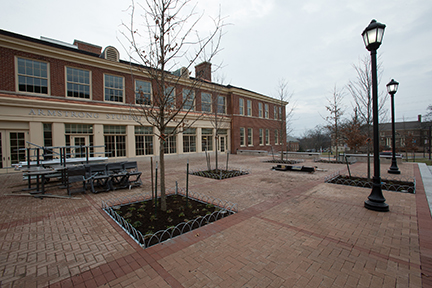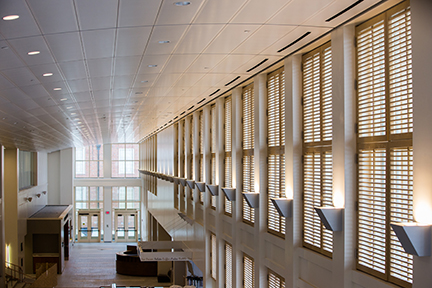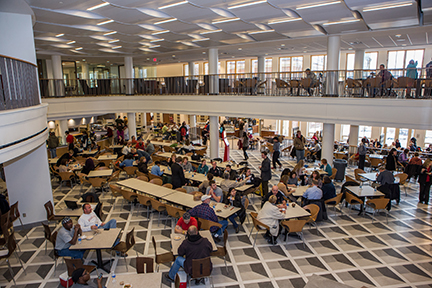
Armstrong Student Center: Red brick and green building
Miami University's commitment to students demonstrated by the new Armstrong Student Center also reflects a commitment to sustainability with many green design features built into the red brick center.
Miami has committed that the center, like all major buildings and renovations, achieve a 'Silver' certification by the U.S. Green Building Council's Leadership in Energy and Environmental Design (LEED) program.

The Armstrong Student Center's Joslin Family Terrace uses exterior paving incorporating materials with a high solar reflectance index (SRI) value, reducing the heat island effect (photos by Scott Kissell).
Highlights of the sustainable building practices employed in the Armstrong Student Center include:
Green in construction: Recycled materials, locally sourced
• The use of recycled content was emphasized in building material selection, with more than 20 percent of the materials installed on the project being from a recycled material source.
• More than 20 percent of the building materials were extracted and manufactured within a 500-mile radius of Oxford.
• More than 90 percent of the construction-related waste was diverted from the landfill and instead recycled through sustainable demolition and construction techniques and thoughtful planning.
• Exterior paving incorporated materials with a high solar reflectance index (SRI) value, reducing the heat island effect of the areas around the Armstrong Student Center.
Green on the inside

Interior spaces "harvest" daylight to naturally illuminate in the center, particularly the Galleria and Slant Walk spaces.
• The building is designed to meet Miami's new energy efficiency standards. It requires approximately 35 percent less energy to heat and cool (per square foot) when compared to the previous student center at Shriver Center. How? Motion and CO2 sensors adjust lighting and ventilation based on occupancy.
Thermostats are programmable and can be remotely controlled. Kitchen fume hoods have sensors that vary fan speeds based on conditions, reducing loss of heated/cooled air by approximately 50 percent.
• The interior employs smart heating and cooling systems to ensure comfort. Daylight is "harvested' to naturally illuminate the interior Galleria and Slant Walk spaces.
• Restroom fixtures use 40 percent less water than already efficient standard models.
• Miami's green cleaning procedures will play a role in maintaining the health of the indoor air quality for building users as well as maintenance staff.
Green dining
• All packaging used in the center's six dining concepts is compostable.
• A new food waste pulper and dehydrator press handles compost and leftover food. The equipment can process 200 pounds of ground waste into 20 pounds of compostable product after dehydration.

The center's six dining concepts use compostable packaging and a food waste pulper and dehydrator press which can process 200 pounds of food waste into 20 pounds of compostable material.
Miami's first pulper and dehydrator press was implemented at MapleStreet Station last fall. These will become standard equipment for Miami's new dining centers, said Jon Brubacher, purchasing and operations analyst for housing, dining, recreation and business services.
Repurposing preserves character
• The 203,000-square-foot Armstrong Student Center preserves the character and tradition of campus by repurposing the former Gaskill and Rowan halls connected by a new central structure. Culler Hall will be repurposed in an east wing expansion.
• The center's central campus location makes it easily accessible to pedestrians, bicyclists, transit riders and nearby parking structures.
• Miami's transit system earned the Armstrong Student Center an “exemplary performance” credit, which is granted when a project doubles the performance requirements/metrics of select LEED credits.
Written by Susan Meikle, university news and communications, with contributions from John Seibert, senior project director of the Armstrong Student Center
